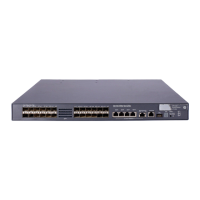213
packets to 3. If the negotiation succeeds, all FCoE and FIP packets that the server adapter sends to the
device carry the 802.1p priority 3.
To configure APP parameters:
To do… Use the command… Remarks
1. Enter system view
system-view —
2. Create an Ethernet frame header
ACL or an IPv4 advanced ACL
and enter ACL view
acl number acl-number [ name acl-
name ] [ match-order { auto |
config } ]
Required.
An Ethernet frame header
ACL number ranges from
4000 to 4999. An IPv4
advanced ACL number
ranges from 3000 to
3999.
DCBX Base Protocol Rev
1.0 supports only Ethernet
frame header ACLs. DCBX
Base Protocol Rev 1.01
supports both Ethernet
frame header ACLs and
IPv4 advanced ACLs.
Create a rule for
the Ethernet frame
header ACL
rule [ rule-id ] permit type protocol-type
ffff
3. Create a
rule for
the ACL
Create a rule for
the IPv4 advanced
ACL
rule [ rule-id ] permit { tcp | udp }
destination-port eq port
Required.
Use either approach.
Create rules according to
the type of the ACL
previously created.
4. Return to system view
quit —
5. Create a class and specify the
operator of the class as OR
traffic classifier tcl-name operator or Required.
6. Use the specified ACL as the
match criterion of the class
if-match acl acl-number Required.
7. Return to system view
quit —
8. Create a traffic behavior and
enter traffic behavior view
traffic behavior behavior-name Required.
9. Configure the behavior to mark
packets with the specific 802.1p
priority
remark dot1p 8021p Required.
10. Return to system view
quit —
11. Create a QoS policy and enter
QoS policy view
qos policy policy-name Required.
12. Associate the class with the
traffic behavior in the QoS
policy, and apply the association
to DCBX
classifier tcl-name behavior behavior-
name mode dcbx
Required.
13. Return to system view
quit —
14. Apply the QoS policy to the
outgoing packets globally
qos apply policy policy-name global
outbound
Required.

